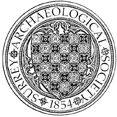Saxon County School, Shepperton
Excavation by R J Poulton for SCC in advance of building work. A flint scatter and a Mesolithic tranchet axe indicated prehistoric activity in the area, and RB pottery and tile suggested a nearby site, whose whereabouts were possibly identified by a resistivity survey. The excavation produced a substantial early Saxon midden deposit, with much bone and pottery, the latter of a number of different types. There were also late Saxon ditches parallel to previous discoveries, and a scatter of medieval pottery. (216)


